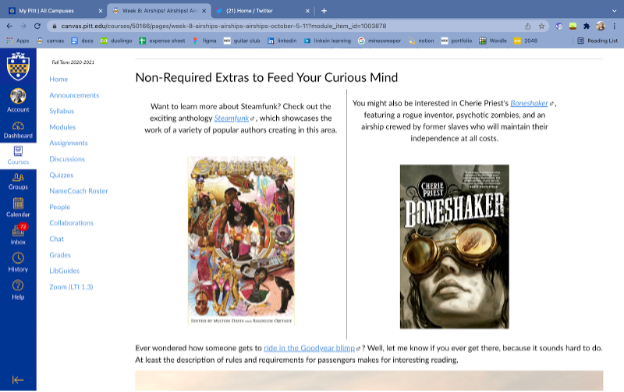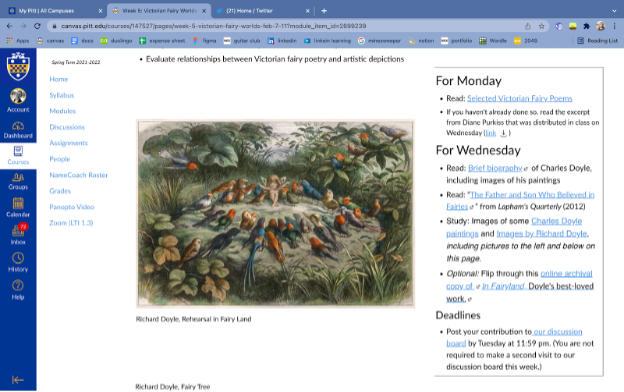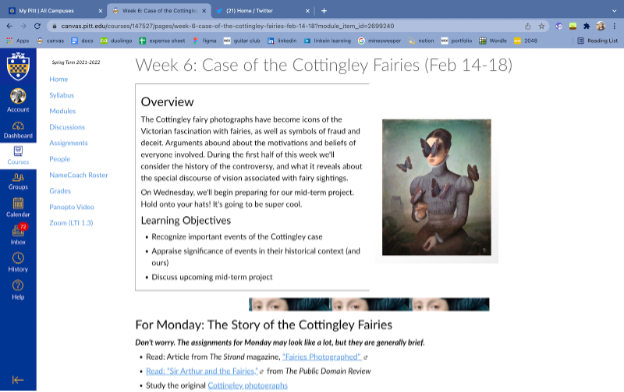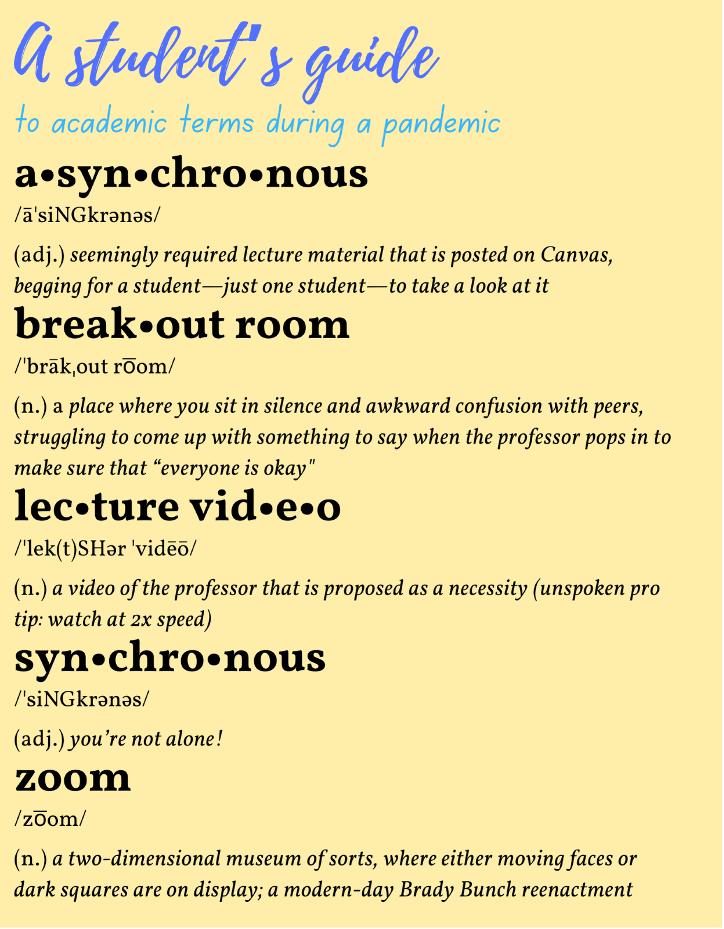So, what is the “traditional college experience” really like? Did it become lost during the pandemic, or did it just get reimagined? Did it ever really exist in the first place? Most students will say that the pandemic ruined their time in academia. The events that unfolded in the world were hard to bear. We were all confused at some point, and—let’s be honest—we’re all still a bit confused now. But you have to pick back up where you left off.
Gayle Rogers, chair of the English department, looks back on when the pandemic started to raise questions about what was happening with teaching and learning. “The first experience was that my inbox went insane. I was getting about 300 emails a day; and rightly so, a lot of people just had a lot of questions,” Rogers said. As part of lower-middle management, he didn’t decide any University-wide policies—but he guided the English faculty through the confusion. Teaching and learning during COVID brought up things that we’ve never thought about before: whether or not Zoom should be permitted once classes began in-person, masks being worn correctly, the obstacle of getting students to be fully present online, and more.
In March 2020, during the University’s spring break, the transition to fully online classes began. For the rest of that spring semester, almost nobody was on campus; instead, everyone was behind their computer screen, isolated from one another at home. During the 2020–2021 academic year, Flex @ Pitt was the style of teaching—some students and faculty were on campus, others were at home; there were options for a hybrid style of learning. Pitt instructors got to choose if their class was fully online, or in person with an online option. During the 2021-2022 academic year, classes were fully in person, with short periods of online-only learning at the beginning of each semester to allow for quarantine after community members returned to Pittsburgh.
Despite all things bad during the pandemic, teaching during Covid allowed instructors to sharpen skills and learn more about their students in beneficial ways. Neepa Majumdar teaches Film & Media Studies as an associate professor. Transitioning to teaching online was “challenging, but not hard,” she recalled, as her summer—like that of other professors and instructors—filled up quickly and heavily with seminars, web conferences, and online modules about Canvas, Zoom, Panopto, and Microsoft Teams.
Moriah Kirdy is the associate director of the Dietrich School Institute for Writing Excellence, and teaches Public and Professional Writing and Composition classes. At the start of the academic year in 2020, she planned for the Writing Institute’s big launch at Phipps, where people could introduce themselves, share ideas, and write together. Instead, the program launched over Zoom. While the program continued to build and succeed, the Composition program’s administrators, the Writing Institute, and faculty gathered for several meetings in June and July to discuss Flex @ Pitt and the challenges of the program’s newly online courses. The discussion-based forms of Composition courses were difficult to adapt to an online format. So a three-part faculty seminar was created: a pre-workshop; a concentrated Q&A with Marylou Gramm, the director of undergraduate studies for Composition; and a topics workshop where faculty within the program presented different teaching tips that they had learned about related to teaching online.
While the Center for Teaching and Learning helped faculty and faculty helped each other transition their classes to fully online, the University underwent the transition from BlackBoard to Canvas in the summer of 2020 as well. BlackBoard was the University’s online hub for classes, organizing reading materials, discussions, and assignments for ready student access. Canvas is a more modern version of that, and it offers pages to organize class materials: grades, syllabi, assignments, Zoom links, discussion boards, quizzes, announcements, modules, you name it. Neepa Majumdar noted that one of her colleagues who isn’t as tech-savvy as most ended up loving the use of Canvas. If they could make the transition, so could anyone!
Canvas provides faculty and students with creative—and sometimes fun—ways to display and organize class content. Associate Professor Hannah Johnson familiarized herself with Canvas and online learning for a few summers before COVID began and had tinkered with it through the years. In August 2020, she was one of the English department faculty offering her own workshop, showing instructors how to build Canvas pages, using her ENGLIT Steampunk class as an example.

Johnson provides “Non-Required Extras to Feed Your Curious Mind” on every lesson page for students interested in reading, watching, listening, seeing, or building more content related to class. She even built her own “scavenger hunt” in ENGLIT 0717 Fairy Tradition by creating invisible links on photos, prompting students to another webpage that offered extra credit work. 

During the pandemic and online teaching, professors uploaded lecture videos on Canvas for students to watch asynchronously. Neepa Majumdar commented that recording lectures required her to really tighten and polish her class content. “Less is more,” she explained. “Trying to pack everything in because you know so much ... is not helpful to students.” In a classroom setting, it feels easier to ramble off on side stories, or see where students are either comfortable with the material or are confused based on their body language. Recorded lectures need to be engaging. They need to be useful. They need to be accessible.
And all the challenging work paid off in the OMETs—student surveys on teaching. Gayle Rogers stated that at the end of the first online half-term after COVID hit, there were bad remarks. But they weren’t so much about the instructors themselves; it was frustration and burnout from the pandemic. When instructors learned more about online teaching and got into more of a consistent online routine with their students, their reviews improved gradually as the pandemic progressed. The online learning ratings stayed around average/below average, but instructors’ ratings increased as time went on.
On the other side of the screen from professors were the students. While professors learned, researched, prepared, and presented classes online, what did students do?
When classes started back up in person in the fall of 2021, the energy came back to campus. Students set up in their seats at least 15 minutes early, best outfits were worn, and masks were the only things stopping us from seeing all friendly faces. It was like a fresh start; those days of sitting in home offices and listening to lectures from the couch were over. It might’ve been a little awkward figuring out where to sit again or asking someone’s name three times in a single class period, but we were mostly all finally here.
We heard everything on the first day of in-person classes, from “It’s so weird not conveniently seeing everyone’s names next to their faces!” to “Everyone looks so different with masks on!” and even a solo “wow” followed by a head nod and smiling eyes, finally soaking in the reality that we were once used to all over again. Even though in-person classes did not start until a few weeks into the fall semester, Jamie Sheppard (Class of 2024, Public & Professional Writing) noted that, in most of her English Composition classes, the professors reintroduced everybody after meeting on Zoom for two weeks to gain a sense of welcome-back-onto-campus-and-into- the-classroom.
Sheppard had started her undergraduate studies at the University of Pittsburgh online from her home. When she realized that all of her classes were going to be online, she reasoned that living at her home was more ideal for the already remote semester. All—if not most—of the tools that students needed were online. In the English department, most writing-intensive classes are around 20 people. Another student, Jennifer Booker, recalled that, in seminar settings, professors tried their best to get everyone to turn their cameras on, as this made it feel more personable. And it turned out that showing one's face “did wonders for people’s participation,” she said. She also pointed out that professors opened up online chats via Zoom or Canvas, where some students were able to type questions, thoughts, and jokes into the chat, which also boosted discussion, participation, and interest in class. 
As seminars and lectures began to run in full swing, interpretations of course policies changed. Flex @ Pitt began in the middle of the semester when COVID hit, allowing both students and faculty to learn and teach remotely or in-person. However, according to Moriah Kirdy, this could cause two variations of the same course to run simultaneously, which meant that there was lots of wiggle room for the interpretations in the collaboratively developed policies of the English Composition program. Even so, flexibility can be intimidating—as everything is up in the air—but also useful, as the new format of teaching allowed instructors to re-evaluate how student work was assessed. Writers are constantly growing and changing, which arguably matters more than quality of writing—process over product. Contract grading has recently become popular to highlight labor-oriented assessment, allowing students to have more agency and control over their work.
And once in-person classes were again mandatory, attendance policies have evolved. There have been rising cases and variants of COVID, constantly changing mask mandates, vaccination statistics, and more that have contributed to attendance policies. However, some policies have also, by necessity, become more fluid. Whether students or faculty are going through problems related to physical or mental illness, family, or the pandemic, the bottom line (for the most part) is: Just be in touch.
In the end, we all learn from each other. Two years ago, teaching and classes and school had a much different philosophy. We are going through profound times and changes. Students and teachers work with each other in different perspectives now; in a way, it is humbling and brings us to the reality of the events that are happening outside of the academy. Through working together through the pandemic, we accomplished so much. Ellen Smith, editor of The Fifth Floor, reflects: “It puts the humanity in humanities, and I hope it did for my students, too.”
—Olivia Wyland
Olivia Wyland is a senior majoring in Public and Professional Writing with minors in History and Writing (Nonfiction). She is The Fifth Floor's associate editor.
"A Student's Guide" created by Olivia Wyland.
